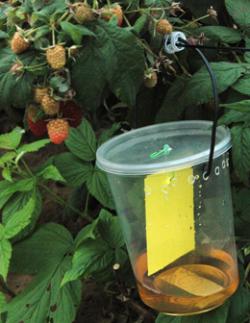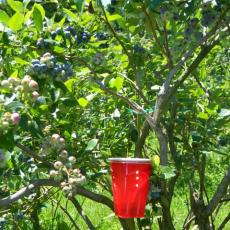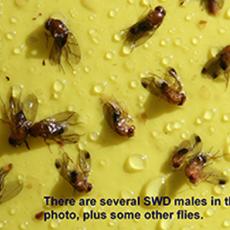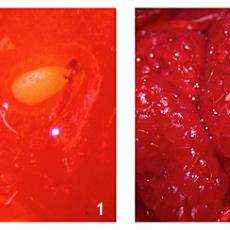Spotted Wing Drosophila Monitoring
Keys to successful SWD management are understanding the pest's biology (life cycle and host range) and timely management action to protect susceptible crops. In order to determine if and when SWD populations are infesting your crops it is important to deploy traps that will attract and capture adult flies of this pest. Checking fruit for larvae is also important.
Instructions to make easy and inexpensive traps (shown below) for adults.
Traps
- Use traps to establish presence and abundance of SWD
- Set traps out prior to fruit ripening to establish onset of infestation
- Fill trap with 1/2 cup of Cider Vinegar plus a drop of unscented dish soap or other bait (see below)
- Hang yellow sticky card inside trap above bait (optional)
- Place traps within the canopy of the crop in a shaded (but not obscured) location
- Check traps frequently (at least once per week) and confirm any suspected SWD captures using identification keys (see links below)
- Replace bait weekly to maintain effectiveness (don't dump old bait on ground; remove from field)
Bait
 Bait solution recommendations are the subject of a lot of research and trials. While the simple bait of Apple Cider Vinegar (ACV) will attract SWD, there are some additions to that bait that may make it work better. These include the addition of alcohol, yeast, whole wheat flour, sugar and salt (to prevent the formation of 'mother of vinegar') to ACV in various proportions.
Bait solution recommendations are the subject of a lot of research and trials. While the simple bait of Apple Cider Vinegar (ACV) will attract SWD, there are some additions to that bait that may make it work better. These include the addition of alcohol, yeast, whole wheat flour, sugar and salt (to prevent the formation of 'mother of vinegar') to ACV in various proportions.
Each year we maintain an SWD trapping network, especially in the early season, to help us understand the population dynamics of this pest as it evolves from year to year. We have used a variety of different trap designs and lures, all of which have worked to one degree or another. Currenlty we are favoring the use of diluted Concord Grape Juice as a lure and drowning solution in traps. This is because of ease-of-use, effectivness in attracting SWD, and affordability. Other trap lure combinations can also be used. A few options can be seen below:
 ACV Drowning Solution
ACV Drowning Solution
4-6 fl oz of ACV
1-2 fl oz of white wine
drop of unscented dish soap (to break surface tension)
pinch of salt (to prevent formation of 'mother of vinegar' gel)
Checking Fruit for Larvae
 SWD larvae (maggots) may be present in fruit even if adult SWD have not been confirmed. Monitoring fruit for larvae can help verify the presence of this pest. Make sure you only use sound fruit in the test or the larvae you find might not be SWD. Only SWD will infest otherwise sound marketable fruit.
SWD larvae (maggots) may be present in fruit even if adult SWD have not been confirmed. Monitoring fruit for larvae can help verify the presence of this pest. Make sure you only use sound fruit in the test or the larvae you find might not be SWD. Only SWD will infest otherwise sound marketable fruit.
To check:
- mash fruit in a zip-lock bag
- add a salt solution (1/4 cup salt to 4 cups water)
- larvae will float at the solution surface, while fruit will sink
- SWD larvae are white, about 1/8 inch long when full sized
You can also pull fruit apart to check for larvae. If raspberry receptacles are stained with juice, SWD larvae may be present, though staining may also simply indicate overripe fruit. Look for a small oviposition hole surrounded by decomposing fruit tissue as a clue for finding larvae or pupae.
Rutgers University has a full Larval Extraction Fact Sheet.
Identification
- Use sticky cards inside traps or sieve contents to and check to confirm presence of SWD (males are easiest to see)
- Use information in the ID & Biology section of this website to help with identification
- Use hand lens and ID key for additional help
- Record date and number of SWD caught to determine trend
Additional Resources on Monitoring for SWD:
Penn State SWD Monitoring Fact Sheet
University of Maine Trapping SWD Video




